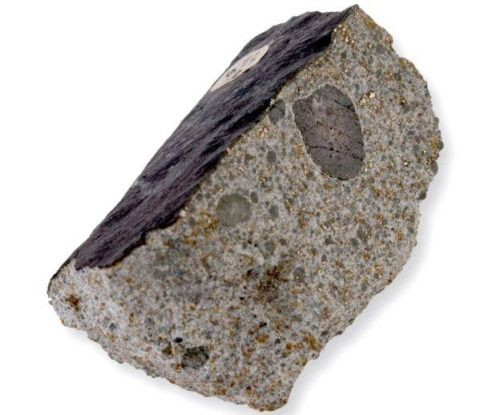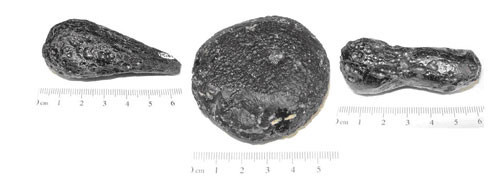The truth about meteors
generally a general noun that names objects from space and collides with the surface of the Earth and this noun is still used to be used for a number of different space objects (asreroids, meteoroids, tektites . .).
In terms of science, asteroids are the solid forms that are lost in the universe, the origin is still controversial, the size varies a lot, sometimes up to several hundred or several thousand kilometers long.

Meteors in the British National Museum of History.
Asteroids wandered indefinitely in space , if they were directed towards the earth, they would be called meteoroids . When touching the Earth's atmosphere at high velocity, meteroids will ignite due to friction with an oxygen-rich atmosphere. Meteor (meteor) is a small meteoroids that completely burns and destroys , if the large and incomplete meteoroids size will break down the earth's crust, they are called meteorites, meteorites.
The chemical composition of meteorite debris is not different from the rocks of the globe, they are divided into different main groups, but they are concentrated in nickel, iron, and magnesium . compared to ordinary rock groups. Earth.

Common forms of Tektites.
Approximately 30,000 to 80,000 meteorites plunge into the earth every year, but most are small in size and are destroyed in the atmosphere, meteorites that reach the ground are often found less because most fall into the sea. . Some regions can find meteors including deserts and polarities, the British Barwell meteorite is the most typical pattern found on Earth's crust.
Large meteorites that collide with the Earth's crust are not direct but only slip through the Earth's crust and continue their journey through space, though their traces leave an impression on the craters, meteorite crater . The largest meteorite pit on the earth's crust, Vredefort Dome, is in South Africa with a diameter of about 300 km. Flagtag Arizona meteorite crater, USA is the most typical model recorded with a diameter of about 1.6 km, the time of impact about 10,000 years ago.
Some scientists have hypothesized that in the early stages of the earth, it was the collision of meteorites into the earth that brought some elements needed to synthesize organic materials, origin. life on earth. However, it was this impact on another view that led to the eradication of the creature on Earth. The dinosaur extinction along with some other creatures 70 million years ago, is believed to be due to the impact of a large meteorite on the earth where the collision location is defined as the current Yucatan peninsula, the Caribbean Sea. . In theory, the collision results in large fires on the earth's crust and into the atmosphere a huge amount of ash covered the sunlight for a long time, destroying the growth of plants because photosynthesis is no longer possible.
Disrupted food sources, high-level groups of creatures (carnivorous dinosaurs or grass) are the groups most directly affected and eradicated. These extinct patterns were also found many times during geological times since the earth was established, indicating that this was not a rare phenomenon.

Flagtag area of Arizona, USA.
The impact of meteorites and meteorites on the earth's crust creates another rock, tektites , often called sky rocks.
The origin of tektites is still controversial, they are materials brought from the twin brother of the earth - the moon; or they are formed in the collision of meteorites on Earth.
Without much debate about these theories, most scientists agree with the view that tektites formed during the collision of meteorites on Earth. Extremely high pressure and heat generated during the collision melted and smashed the materials of the earth's crust (rich in SiO 2 ), which fell to the ground again, while falling they would solidified, so when they reach the ground they have teardrop-shaped shape and out-of-hole shape where the air bubbles form while solidifying. Tektites is very similar to the shell stone (obsidian) , a type of SiO 2 rich volcanic rock on the ground.
In Southeast Asia, meteorites are found in many places in Vietnam, Laos, Cambodia, and Thailand ., about 700 thousand years old, they are named Indochinites (tektites of Indochina region) . The location of the impact of the celestial body on the earth's crust in the region has not been clearly defined, the Tonglesap Lake (Cambodia) has been a position raised by scientists. Recently, other studies have shown that the collision location may be in central Vietnam or part of Laos.
Even though the controversy over the origin of meteorites - tektites comes from space or is simply formed in special conditions when celestial bodies (meteorites, asteroids) collide with the surface of the earth's crust, they are merely is a type of stone. Rock heaven, tektites in its true sense can be found easily everywhere in the gem souvenir shop in many cities in Southeast Asia, their names are Indochinites - meteorites of Indochina (Indochina ).
- The American spacecraft will crash into the meteorite
- Video: Huge meteorite glides through the American sky
- NASA continues to hunt for dangerous meteors
- NASA asked people to hunt for killer meteors
- The meteorite that cleans humanity is just a matter of time.
- Meteors explode into night in Siberia
- Things you don't know about meteors
- Meteors exploded near the US air base
- The 5 largest meteors ever plunged to Earth
- Russian meteorite turned into
- Meteors speed over 140,000km / h rush through the sky
- Does a true drug exist?
 Van Allen's belt and evidence that the Apollo 11 mission to the Moon was myth
Van Allen's belt and evidence that the Apollo 11 mission to the Moon was myth The levels of civilization in the universe (Kardashev scale)
The levels of civilization in the universe (Kardashev scale) Today Mars, the sun and the Earth are aligned
Today Mars, the sun and the Earth are aligned The Amazon owner announced a secret plan to build a space base for thousands of people
The Amazon owner announced a secret plan to build a space base for thousands of people What would happen if you dug a hole through the Earth and jumped in?
What would happen if you dug a hole through the Earth and jumped in?  Chilling discovery of cosmic object that almost brought the Earth to 'apocalypse'
Chilling discovery of cosmic object that almost brought the Earth to 'apocalypse'  The Sun goes into hibernation, will the Earth usher in a new ice age?
The Sun goes into hibernation, will the Earth usher in a new ice age?  Discovery of space object powerful enough to tear apart the Earth
Discovery of space object powerful enough to tear apart the Earth  NASA to test 'pneumatic brakes' for Mars lander
NASA to test 'pneumatic brakes' for Mars lander  Breakthrough discovery of planet with more water than Earth
Breakthrough discovery of planet with more water than Earth 